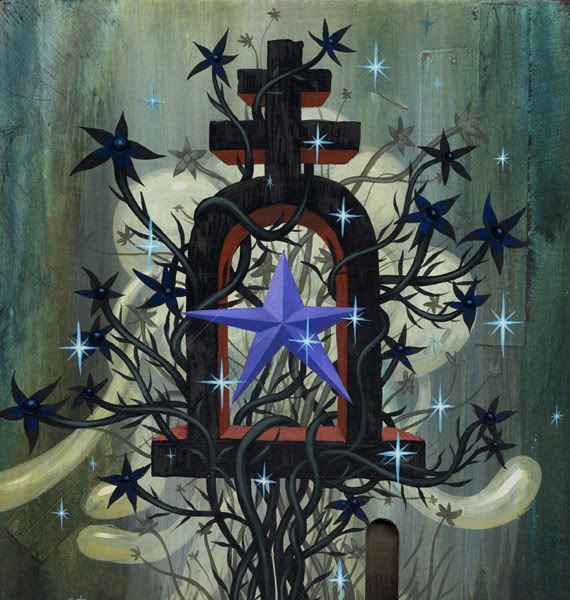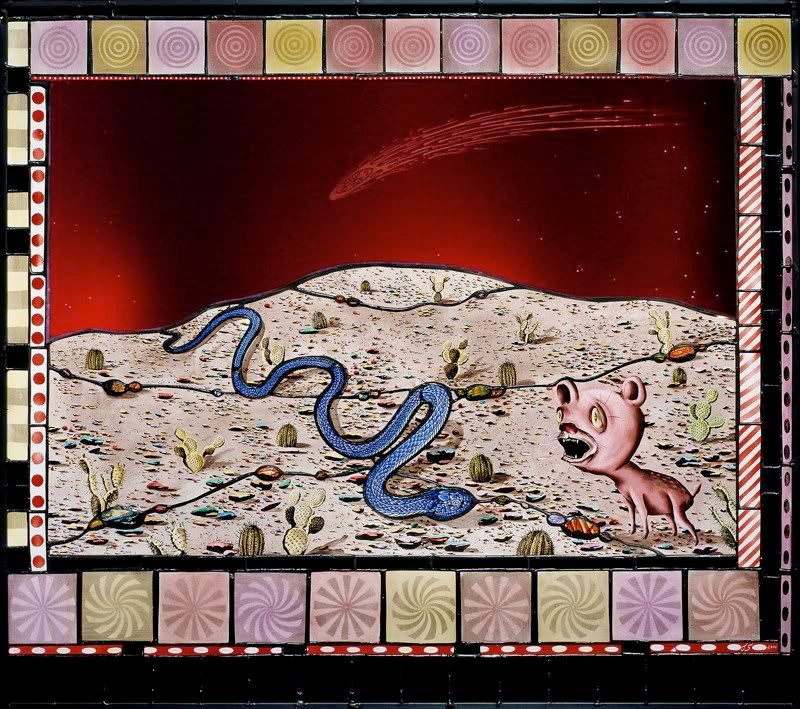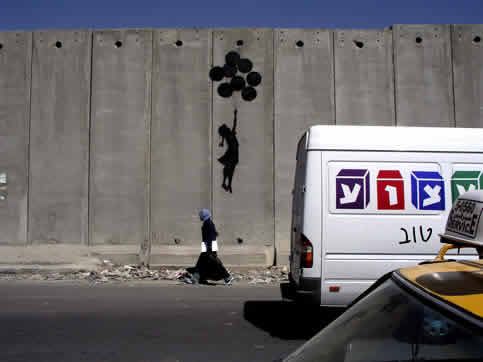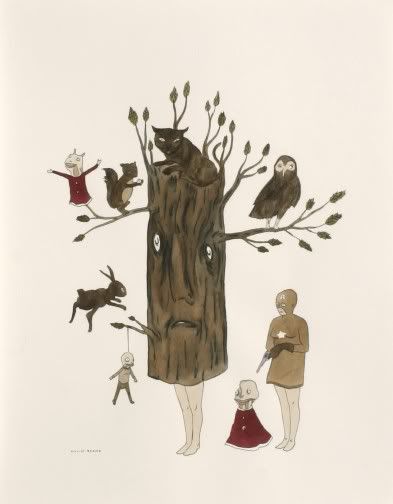
Issue of Juxtapoz Magazine
Cover art by Shepard Fairy
"A frog is either lowbrow or highbrow.In 2007, commenting on the blog PaintersNYC, artist Kelli Williams observed that it's hard to be a Juxtapoz artist "in an ArtForum world." Juxtapoz is a popular magazine dedicated to showcasing contemporary "lowbrow art." It was founded by the artist Robert Williams in 1994. The "ArtForum world" of Kelli William's statement references the magazine of that name, but also the "high art" scene it covers, of which New York City, for the time being, remains an - if not the - epicenter. Until recently, the artwork featured in ArtForum was very different from that seen in the pages of Juxtapoz. Juxtapoz is representative of the Los Angeles art scene, and the U.S. west coast scene more generally, where the aesthetics of pop surrealism, folk art, post-graffiti, or street art are wholly embraced.
If you catch it, it's low. If you order it in a French restaurant, it's high."
-Unidentified chef, from Burkhard Bilger's Noodling for Flatheads
But artwork infused by Juxtapoz's colorful spirit is no longer uncommon in New York galleries. Andrew Schoultz, Tim Biskup, and Jeff Soto, talented west coast artists regularly lauded in the pages of Juxtapoz, today exhibit with the Morgan Lehman and Jonathan Levine galleries, and influential post-graffiti artist Barry "Twist" McGee is represented by the renowned Deitch Projects. Jonathan Levine makes plain his dedication to the post-graffiti aesthetic; his gallery's website states that its mission is to exhibit "work influenced by illustration, comic books, graffiti art and pop imagery." Perhaps it's no longer so hard, then, to be a Juxtapoz artist "in an ArtForum world"?
But, more importantly, does lowbrow art require the affirmation of the "high art" world - for easy contrast, let's call it highbrow art - in order to be considered mainstream or legitimate? If so, what exactly is the cultural significance of highbrow art to the world at large?

"Purple Heart"
2007
Acrylic on wood
12 x 12 inches
The commercial success of books like Beautiful Losers: Contemporary Art and Street Culture and Wall and Piece, the latest offering from the infamous British artist, Banksy, suggest that pop surrealism, post-graffiti, and street art succeed in connecting with the multitudes. On the other hand, it's an uncontroversial fact that highbrow art generally doesn't move the masses (with the exception of its remarkable ability to offend the religious sensibilities of the Christian Right and certain mayors). But highbrow art doesn't simply fail to connect with the general population; the fact is, most folks sneer at, mistrust, or resent ArtForum's world.
Perhaps because they feel beleaguered by popular tastes, many players in the world of highbrow art - artists, gallerists, critics, and curators alike - reject the influx of pop surrealism and post-graffiti flavor. But their objections will inevitably prove inconsequential; as the Borg of "Star Trek" put it, "resistance is futile." Even if some of the more esoteric subcultures of the Juxtapoz arena - Tiki culture, for example - are unlikely to find a toehold in the world of "high art," the graphic influences common to post-graffiti work already inform the paintings of contemporary art world darlings like Dana Schutz, Marcel Dzama, Trenton Doyle Hancock, Ryan McGuinness, Lisa Yuskavage, Yoshitomo Nara, and Jules de Balincourt. (In fact, Dzama and McGuinness have been featured in Juxtapoz; it won't be long before other celebrated highbrow artists are, too. One wonders if the lowbrow label will be applicable for much longer.) And then there are artists like Judith Schaechter, whose stained glass works were lauded in the pages of Juxtapoz years before her work hung in the Whitney Museum or before she received Guggenheim and National Endowment for the Arts Fellowships.

"Hyena Snake Comet"
2004-2008
Stained glass
30 x 33 inches
Much of the highbrow resistance to pop surrealism and post-graffiti is rooted in the self-identified elites' distrust of populism. Comic books and strips are intended for mass consumption, but graffiti is unquestionably the most populist of the lowbrow tributaries. No art form has fewer barriers to entry; all you need is a can of spray paint and a little chutzpah. Ask someone knowledgeable about the subject to relate the history of modern graffiti, and you'll likely hear an abridged version, one that begins in the 1970s, in and around New York City's Bronx River Houses, and runs parallel to the development of hip hop. City funding for arts and culture programs was pitifully low at the time, and enterprising teens looked for new ways to entertain and express themselves. As Lady Pink, an influential graffiti artist of the late 1970s and 1980s, explains, graffiti was the most available "forum for free speech."
Of course, the human urge to make marks predates the Bronx River Houses by millennia. Our ancestors depicted their quarry on cave walls and, more recently, citizens of ancient Rome scribbled their political opinions on market stalls (hence the word's etymology, from the Italian graffiare, meaning "to scratch or scribble.") But during the early days of modern graffiti's ascendancy, practitioners prioritized ego over observation or socio-political commentary. The pioneers of the 1970s and 1980s graffiti scenes in New York City and Philadelphia - Taki 183, StayHigh 149, Cat 161, and Cornbread, among others - were primarily known for their "tags," stylized monikers spray painted on walls and subway cars. They vied for renown by tagging as many surfaces as they could, and walls that were difficult to access had a special cache. The competitive behavior of these early graffiti "artists" might be best described as base scent marking, activity essentially indistinguishable from the industry of the bored high school student who scratches "(x) was here" on the wall of the bathroom stall. Fortunately, as more artists entered the nascent graffiti scene, such adolescent "battling" became insufficient impetus; soon, the egotistical tag evolved into something more colorful and complex. Artists added characters, often comic in nature, a result of their limited palettes and time frame, and, before long, these characters evolved into "pieces" (short for masterpieces). The best graffiti artists came to value style and artistry as much as placement.
The conceptual and social strengths of graffiti and street art are rooted in the artists' acceptance of temporality and his or her desire to engage the environment and citizenry directly. As Simon Hattenstone, a features writer for The Manchester Guardian, writes, "Since spotting my first few Banksies I have been desperately seeking out more. They make me smile and feel optimistic about the possibilities of shared dreams and common ownership." Insofar as it is truly democratic, the street artist's approach is fundamentally distinct from that of those who aspire to "high art" success. "Fine artists" are essentially aristocratic in inclination. They are the elites who operate within the context of "high art" institutions; their work is most often viewed in semi-sacred, unlived in spaces, by people who talk about the work in reverent whispers. Street art, by contrast, is viewed by everybody who happens past the artwork. But, today, as the post-graffiti movement sees many of its more celebrated artists entering the "high art" sphere, the populist flavoring of the culture is eroding.

"Balloongirl"
Artwork on West Bank barrier between Israel and the West Bank
2005
Is the aesthetic melting pot a bad thing? The answer depends on your perspective, of course; personally, I'm all for it. Like many contemporary artists, I'm not alone in feeling that my artwork and aesthetic inclinations plant a standard somewhere between the poles of Juxtapoz and ArtForum. Just as I feel torn between my rural roots and the creative community and energy of city life, so too am I drawn to elements of both art orbits, east and west, highbrow and lowbrow. I live and work in New York, so I've cultivated an appreciation for the importance of conceptual heft. But I'm also an erstwhile subscriber to Juxtapoz who, in my youth, eagerly thumbed through the pages of the Advanced Dungeons & Dragons Monster Manual, read fantasy novels and comic books, and honed my drawing chops by copying from comic strips. Perhaps I'm biased, then, but it seems that aesthetic commingling introduces hybrid vigor into otherwise "inbred" scenes.
Too many circles of the "high art" world are poisoned by intellectual pretension, obscurantism, and exclusivity. The ArtForum world is principally concerned with auction results and art historical significance. In east coast MFA programs, the mills of the contemporary "high art" world, a common question asked of students is, "Where does your work fit in the historical trajectory?" Indeed, at great cost to social legitimacy, the "high art" world has prioritized originality and artistic genealogy.
Much of the "lowbrow" scene, by contrast, is blighted by the artists' focus on disposable pop culture, their willingness to cozy up to the marketing machine, and their populist posturing. In an interview with Juxtapoz, one young artist said,
"When it comes right down to it, I draw the stuff I like, and people can take it all for whatever they want. I would say that 95 percent is liking big boobs and butts, the other five percent is brain farts that end up in a sketchbook that later ends up as a painting or whatever."Although I wrote down this quotation without recording the artist's name, I do recall appreciating some of his graphic skill. Still, when I'm confronted with such a thoughtless statement, I can appreciate the animus that brooding, theory-oriented types have for lowbrow art. Where is the evidence of this young artist's vocational mindfulness, his rigorous passion, his poetic sensibility? Of course, his defenders would likely praise his candor, but, in truth, he's posturing as much as the bespectacled, black-clad fellow who insists in his jargon-laden artist statement that Jacques Derrida informs all of his output.

"Untitled"
2005
Watercolor on paper
14 x 11 inches
Despite haughty sneers from individuals on both sides, it seems to me that the transition that so many post-graffiti artists are making, from the streets to the galleries, could (and should) help create a less sectarian art world. The selfish pretensions of the highbrow art world could be tempered by an influx of no-nonsense, illustrative exuberance, and the lowbrow art world could jettison some of their conceptual superficiality by taking the philosophical and moral obligations of their vocation more seriously. That is, in any case, my hope.
Image credits: Juxtapoz cover image ripped from Rotofugi.com;; Jeff Soto image ripped from the Jonathan Levine Gallery website; Judith Schaechter image ripped from the artist's website; Banksy image ripped from the Brian Sewell Art Directory; Marcel Dzama image ripped from David Zwirner website
(Note: This post appeared concurrently on the art blog, Hungry Hyaena.)
5 comments:
Hello, hello? Anyone home? Wheres Balhatain?
Oh well, this is copied over from HHs site, enjoy. Or not, however it may pertain to you.
Donald Frazell said...
"High" brow art went low brow decades ago, it no longer has its roots as it severed them to sell to its targeted audience, just as "low" brow art has its. And Low brow includes far more of modernism than the supposedly higher descendant of creative art. Posters are decidedly cubist in structure, formally modern, while selling individual items on a field that is spread out for dramatic and structured for impact.
Yes, Tolouse-lautrec retains some evidence of imfluence, but very little and only on some. The graphics are more soviet in the above poster of Fairleys, who were built off of Suprematism and Constructiism. Again simplified and dogmatic takes on cubism from Cezannes influence.
With each generation we get farther from our roots, thinking we have evolved, and become more, while truly we have become less. By including only that of our day, no longer built on a solid foundation of mankinds thousands of years of civilization.
So lowbrow may actually be more creative than highbrow now. It has a heritage, from other sources as well, and though sometimes its graphic sense is like Mad magazine, closer to blowing noodles out ones nose than watching the sunset through huge trees in mountainouse terrain. God is now absent in both, but at least lowbrow has humanity, if at its LCD.
Art must be HCD, but still common to the vast array of humanity throughout the world, and of social status. Art must be able to be understoood by anyone from any culture of any class, simply an intelligent inquiring, sensitive mind, body adn soul must be present. Instead, highbrow is for a small subsect of humanity, closed off, arrogant, above the rest. When truly infantile and afraid.
Artists need to be much more physical than they are, or otherwise become locked inside their bodies and small worlds. They msut feel the breath and pain of exertion, of work, of accomplishment of the body. As well as the mind, balance is key. Or the soul withers and dies.
I see little difference between high ahd low, except the high has more expensive materials and are often hyper self-sensitive, while low wants to shock in crude ways. Its Three Stooges vs Marx Brothers. But it is all still a joke. On them. As the rest of humanity left long ago, more interested in sport. Porn was always there, now we have a fixation on games, but of strictly teh mind, that of the body uses the mind in equal amounts to win, and takes passion, so a soul is present.
Games, amusements and decoration is arts role now. Marketing its highest form. Whether it will remain that way, we will eventualy see. Or will a Highest Common Denominator return, to define, inspire, and focus us unto Purpose. It was once so.
art collegia delenda est
Institutionalized Mediocrity numbs the soul
And to tell the truth, I would like a MORE sectarian art world. The crap took over and there is little room for anything that goes against the status quo put out by the academies. The "gallerists""curators" and vanity gallery owners are completely brain washed. Its all the same shallow drivel now, a buncha kids with MFAs before their names who think they are preapared for the real world, and these fools marketing them as such. In no other job in the world are kids out of college considered ready for top jobs. They have but the basics, and less than that these days.
As music has categories with real creative musics like jazz and classical, then others that may have some real artists like folk, blues, and r and b, then pure trash like pop and rock and country, though some country did have worth back in the day, its more Eagles type poprock now. And Jimi Hendrix and Duane Allman proving the rule of incompetency in rock. They were truly advanced blues players.
This stuff is Fine as entertainment, even a little passion every once in awhile, but far from being art. With a few indies like Bob Marley, as most reggae ssucks, he was the exception that proved the rule as did Dylan and Joni Mitchell who went towards jazz with Jaco and Shorter and Hancock as she was more complex musically than popsters could possibly handle.
Let there be a seperation, its then up to the people to choose, but at least it can be found and out there. Not so in art, which is controled by a tiny group think, thinking their silly degrees actually mean something. Few if any great artidts evere graduated from art or music schools. They are papers toward career and professionalism, not creative art.
There are many forms and purposes in art. Applied arts, entertainment, decoration, illustration, fine arts for the rich, and true crrative art, which fulfills the purpose of that which lasts. I think you know waht that is by now, and are searching in tehat direction. Mankind, nature adn god. Only man the individual lives in the academies, Humanity, nature, and god especially were abandoned long ago. And we have paid the costs.
art collegia delenda est
I loved this article and agree with several points. As a New Yorker living in LA and a big fan of Juxtapoz, I am a believer that urban art revealed in the magazine allows artists to retain the purity of art which is self-expression, communication to the masses, and no boundaries. I've always wondered about the Art Forum world where alot of pieces are sold at such a high price that tends to ostracize the youth who should be hanging and appreciating art when developing their sense of independence. Art is very subjective and I wonder if "highbrow" galleries comment for the sake persuasive sales. The beauty of art in the magazine seems to reflect artists who care to express themselves and its a golden time to embrace this rawness.
I loved this article and agree with several points. As a New Yorker living in LA and a big fan of Juxtapoz, I am a believer that urban art revealed in the magazine allows artists to retain the purity of art which is self-expression, communication to the masses, and no boundaries. I've always wondered about the Art Forum world where alot of pieces are sold at such a high price that tends to ostracize the youth who should be hanging and appreciating art when developing their sense of independence. Art is very subjective and I wonder if "highbrow" galleries comment for the sake persuasive sales. The beauty of art in the magazine seems to reflect artists who care to express themselves and its a golden time to embrace this rawness.
The bansky photograph is stunning!
Post a Comment